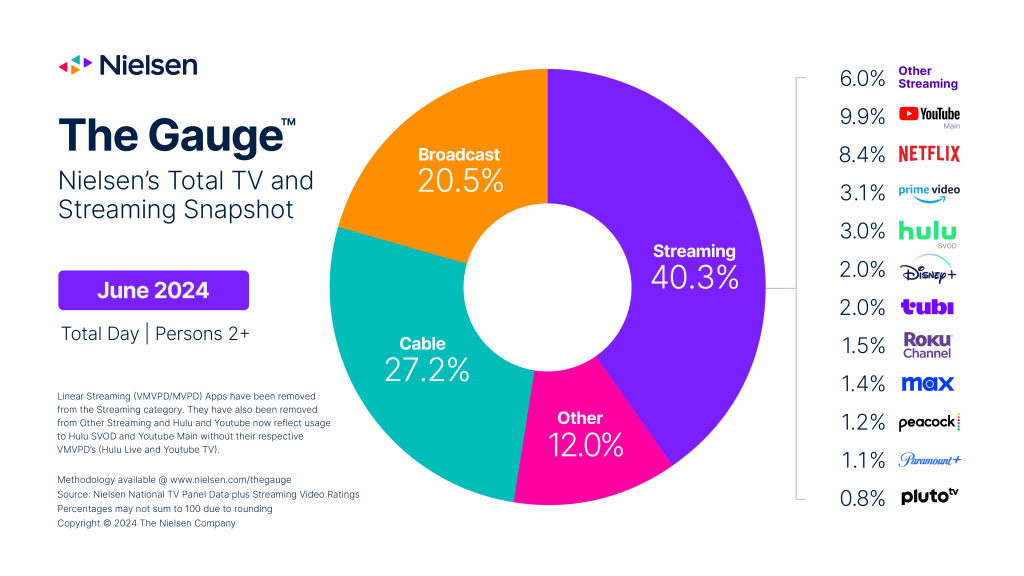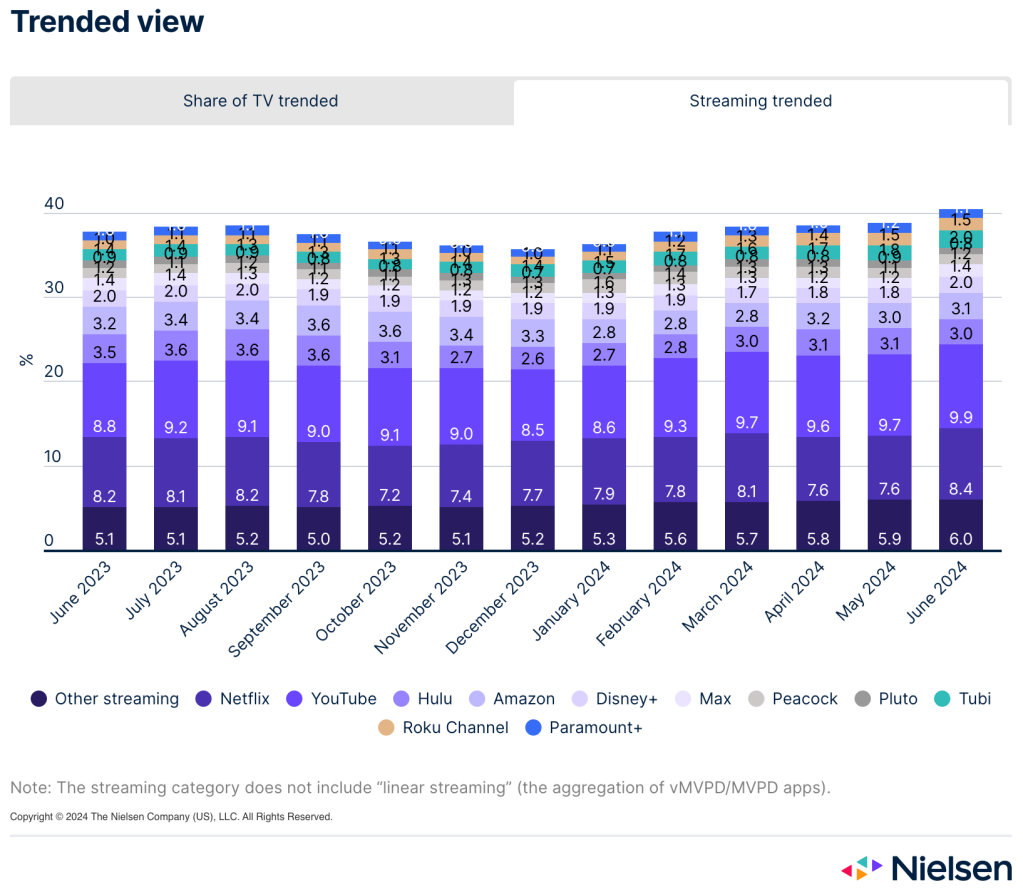Future of TV Briefing: How talent managers see creators’ professionalism levels increasing

This Future of TV Briefing covers the latest in streaming and TV for Digiday+ members and is distributed over email every Wednesday at 10 a.m. ET. More from the series →
This week’s Future of TV Briefing looks at how creators are becoming more professional as they diversify their revenue streams.
- The economy of being a creator
- Why longer videos are becoming more commonplace on YouTube
- TV watch time ticks up again in June
- NBA’s latest rights deals, X’s video plans, India’s post-TikTok fallout and more
The economy of being a creator
Eight years ago, less than 10% of the creators that talent management firm Whalar Group worked with were full-time creators. As of last year, that share had more than flipped.
“Ninety-five percent of the creators we worked with were full-time creators. 70% of the creators we worked with, we were working with their manager or agent. And 20% of them had at least one employee,” said Whalar Group co-CEO and co-founder Neil Waller.
In other words, the level of professionalism among individual video creators has increased fairly dramatically. As covered in last week’s Future of TV Briefing, creators are increasingly hiring managers and editors and even heads of human resources. And they need to in order to build businesses able to withstand a still-developing and oft-fickle industry.
A decade ago, diversification was a major trend among creators. At the time, “creator” really meant “YouTuber,” and the drive toward diversification was fueled by Facebook’s emergence as an alternative, albeit unproven, video platform. A decade later, diversification remains a focal point, albeit with a twist. Diversification with respect to distribution is still important, but increasingly so is diversification with respect to a creator’s revenue lines.
“When it comes to being a creator, it’s really not enough just to produce content,” said Damian Skoczylas, svp of talent at influencer marketing agency Viral Nation.
Content remains the foundation of creators’ businesses, but that content is their intellectual property. And this more recent form of diversification is finding more ways to capitalize on that IP, such as through commerce.
“There’s more ability to build your own products now and have an e-commerce store because you’ve got platforms like Shopify and others. You’ve got more solution providers that can do small-batch orders for people. Or more companies like Kajabi that help you build a course, for example,” said Waller. “So I think there’s more opportunities than there were before.”
More expectations, too.
TV and streaming show buyers, for example, are more willing to take pitches from creators because there’s more evidence of creators being able to make good on those investments. There’s more precedence for creators, such as Issa Rae, proving themselves capable in the traditional entertainment industry. And the increasing professionalism of creators — having hired teams to be working on their videos — can help to make that jump much less of a leap. Case in point: Jimmy “Mr Beast” Donaldson has his own production company that, for years, has been developing and producing videos that cost as much as episodes of high-end TV shows, which helps to make his reportedly $100 million deal with Amazon less of a risk.
But creators like Rae and Donaldson remain a rarity. And while show buyers are more open to creator-led pitches, their bars remain high.
“It used to be just about numbers. When I first started it was like, ‘Oh, they have 25 million subscribers; give them a show,’” said Paul Telner, head of programming at Viral Nation.
To be clear, subscriber numbers count for something, but so does a level of credibility in being able to work on a larger-scale production than the average YouTube video. “That’s why we put our creators through a really healthy and fun and great development process,” Telner said.
If all of this sounds like well-trodden territory — like people in the creator economy have been talking about diversification and IP and professionalism for years and years — well, you’re right. These are not exactly new developments. Instead what’s new is that — given the new crop of creators that have popped up since the pandemic and established themselves as full-time creators — they apply to more creators.
What we’ve heard
“We’re not going to go after that business because it’s part of our core identity to connect people with friends and we don’t want to undermine that by going after long-form video. We understand short-form video doesn’t always do that, but it can.”
— Instagram head Adam Mosseri on the platform’s disinterest in long-form video
Why longer videos are becoming more commonplace on YouTube
Short-form videos may have surged in popularity over the past several years, but the long-form video format is on the comeback trail.
During VidCon, I interviewed top YouTube and TikTok creators about the resurgence of lengthier videos and to what extent there’s a limit to videos’ lengths. Watch the video below.
Numbers to know
20%: Percentage share of streaming service revenue that advertising represented in 2023.
$62.9 billion: How much money advertisers are expected to spend on digital video ads this year.
11%: Percentage of U.S. households that used Apple TV+ in the second quarter of 2024.
$82: The average amount of money people spend per month on TV and streaming subscriptions.
300 million: YouTube subscriber count threshold that Jimmy “Mr Beast” Donaldson has crossed, marking the first channel to reach that figure.
TV watch time ticks up again in June
Despite the onset of summer and the end of traditional TV’s broadcast season, people spent more time watching TV in June than May — the latest sign of streaming’s supremacy — according to Nielsen’s latest The Gauge viewership report.

Broadcast TV and cable TV recorded 1.8 point and 1.0 point drops, respectively, in share of watch time in June compared to May. Meanwhile, streaming’s share increased by 1.5 points to cross the 40% share threshold, with the month marking a high-water mark for multiple streaming services.
“Across streaming platforms, four notched double-digit usage growth including Disney+ (+14.8%), Tubi (+14.7%), Netflix (+11.8%) and Max (+11.0%), all with 20% or more attributable to younger viewers. Additionally, most streaming services exhibited shares that were near or equal to previous platform-bests, while YouTube and Tubi both set high watermarks with 9.9% and 2.0% of TV, respectively,” Nielsen wrote in a company blog post announcing the latest Gauge results.

What we’ve covered
Tubi hits growth spurt, but isn’t part of the streaming wars, CMO Nicole Parlapiano says:
- Despite being a free, ad-supported streaming service, Tubi considers itself separate from other free and/or ad-supported streamers.
- The free, ad-supported streamer accounted for 1.8% of total TV watch time in May.
Listen to the latest Digiday Podcast here.
Teads is exploring sale options as M&A in ad tech heats up:
- Altice acquired the video ad tech firm in 2017.
- Last year Altice Europe reportedly hired Morgan Stanley to advise on a sale of Teads.
Read more about Teads here.
What we’re reading
NBA drafts its latest TV, streaming team:
The league has signed deals with Amazon Prime Video and NBC to join ABC/ESPN as rights holders, though Warner Bros. Discovery may still lobby to win rights away from Amazon or NBC, according to The Athletic.
The platform formerly known as Twitter has made a lot of noise about building itself into a significant video platform, but its programming plans have yet to amount to much, according to Bloomberg.
Four years after the country banned TikTok, many creators are still trying to make up for the missing platform by accumulating followers on Instagram and YouTube, according to Los Angeles Times.
CNN plans layoffs amid digital push:
The WBD-owned news network plans to merge its TV and digital news divisions, with 100 employees expected to be let go as CNN works to build a billion-dollar-plus digital business, according to The Wall Street Journal.
Chicken Soup for the Soul Entertainment’s collapse:
The former CEO of Redbox’s parent company William Rouhana has been accused of misusing company funds, failing to pay employees and denying their health-care benefits, according to The Hollywood Reporter.
Want to discuss this with our editors and members? Join here, or log in if you're already a member.
More in Future of TV

‘A year of loose ends’: Digiday editors share top takeaways from 2025
This year was filled with major developments – from Netflix’s planned WBD deal to Omnicom’s acquisition of IPG to Google’s ultimately cookie reversal – and Digiday editors Sara Jerde and Seb Joseph help to recap the year that was (and wasn’t).

Future of TV Briefing: How the future of TV shaped up in 2025
This week’s Future of TV Briefing looks back at the top topics and trends that overtook the TV, streaming and digital video industries in 2025.

Programmatic agency execs speak out on CTV transparency
At the recent Digiday Programmatic Marketing Summit, agency executives spoke out — on stage and in behind-closed-door town hall sessions — on how they see transparency in CTV.








